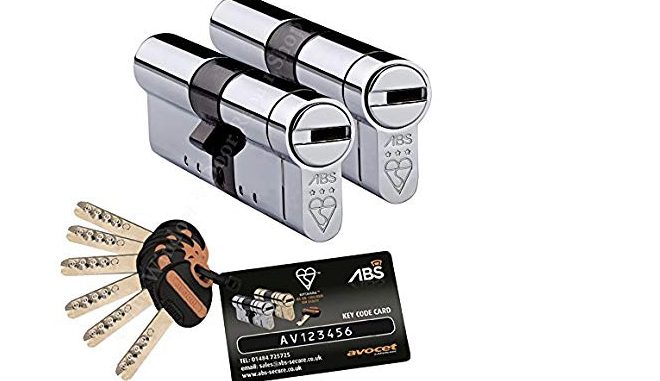
Lock snapping is a common method used by burglars to render a euro lock useless. This involves breaking or ‘snapping’ the cylinder, to expose the inner mechanism, which can then be manipulated to open the door. In some cases a burglar may even break the handles to get better access to the cylinder. It is becoming more and more common, as the amount of properties that now have an uPVC door with a Euro Lock installed has grown significantly.
You may not know that the cylinder is the most vulnerable part of your lock and when compromised it renders your multipoint lock points useless. Lock snapping is not difficult and even an inexperience intruder can manage it. All they need to do is apply the right amount of force to the right part of your cylinder and they can expose the mechanism.
The only way to secure your home from this type of break in is to install an ‘Anti-Snap’ lock. These locks have been designed to withstand a lock snapping attempt by breaking or ‘snapping’ in a certain place. Where point where the lock snaps does not allow access to the inner mechanism, meaning that cannot be tampered with. You will still have to have the lock replaced, but it may have stopped a burglar from gain entry. We are going to take you through the different types of anti-snap locks, so you can learn what you need to take into consideration when buying an anti-snap lock.
1. Sold Secure Diamond Standard
By looking out for an anti-snap lock with a ‘Sold Secure’ sign means that you will be purchasing a lock that has been rigorously tested by Sold Secure, a testing and certification house owned by the Master Locksmith Association.
SS312 Diamond Standard was started in 2010 and is being constantly updated and modified to guarantee that it can withstand newer developed methods of attack. It is tested for resistance to lock snapping amongst other methods of destruction.
2. British Standard
A lock will on get a ‘British Standard’ kite mark, if it has been manufactured in accordance with the criteria set out by the relevant authorities. A lot of insurance companies will often specify that a lock needs to be of British Standard to comply with their criteria. The British Standard stamp is widely regarded as a sign of high quality and means a lock can be trusted to be secure.
In regards to Anti-Snap locks the British Standard is the ‘TS007:2012’. A TS007 will protect your cylinder against many methods of attack, such as; drilling, picking, and bumping as well as lock snapping. If you see a kite marked lock, then it should protect your door from these types of attack. However we recommend that you stay updated with new and different ways to keep your home secure. While every TS007 is of a high quality, within the TS007 category there are 3 star ratings. You may want to look at the differences between these ratings to make sure you have the most secure lock that suits your budget.
TS007 star rating explained
1 Star rating –
For a cylinder to achieve this rating it is tested in the manner equivalent to the BS 3621:2007 and the minimum requirements of BS EN 1303:2005.
2 Star rating –
For security hardware to receive a two star rating the protection offered by the hardware to the cylinder is tested in the manner equivalent to the PAS 24 test. In addition, where possible, the hardware’ durability and corrosion resistance are tested in accordance with the European handle standard EN 1906:2010.
3 Star rating –
For a cylinder to receive three stars, it must meet the requirements of the one star cylinder and also withstand an attack similar to the PAS 24 cylinder test without the benefit of any protective hardware.
3. Yale Anti-Snap Locks
Yale is one of the most recognisable lock brands and any lock made by them can be trusted to be reliable. Yale does manufacture a range of anti-snap locks called the ‘AS Platinum Series Cylinder’. On the Yale website they state;
“Whereas previously Yale AS Series cylinders were approved by Sold Secure SS312 Diamond Standard, we have moved away from this standard and focused all our development activities on the latest British Kitemark standard TS007. Homeowners throughout the UK recognize the Kitemark logo as a symbol of product quality and performance. Yale KM, AS and AS Platinum Series cylinders are all approved to TS007.”
So if you have confidence in the British Standard Kite Mark or your insurance policy states that your locks should be British Standard, then a Yale lock is a good product to go for.
4. ERA Invincible Locks
ERA is another recognisable name within the home security industry. The ERA have been manufacturing, designing and pushing innovation within the industry for over 175 years. They specialise in trusted window and door security as well as smart home solutions.
The ERA don’t use the Sold Standard or British Standard to give their locks a quality rating. They have a test centre that is accredited by UKAS which means they are approved to independently test to a ‘gold standard’ of PAS 24:2012 certification.
Their solution to the lock-snapping problem is to design a euro lock that has a unique shape. The ‘Invincible Cylinder’ reinforces the central fixing hole with 5 times more material than a standard euro cylinder. According to the ERA website the ‘Invincible Cylinder’ boasts many security features including;
Reinforced with five times more metal than a standard cylinder lock – it can‘t be snapped*
6 hardened high security pins for the ultimate anti-pick, anti-drill and anti-bump resistance
Robust shape is a strong visual deterrent to would be thieves
Independently tested to meet the latest security standards: British Standard Kitemark (TS007), Sold Secure Diamond and the police‘s Secured By Design accreditation
The difference between the ERA locks and other anti-snap locks is that while traditionally anti-snap locks are manufactured to break in a certain place, ERA lock are manufactured to not break at all. Therefore giving euro locks ‘fighting chance’ against potential thieves. These means that even if someone does try to use the lock-snapping method to break in, you will not need a replacement. The ‘Invincible Cylinder’ is designed to withstand over 15 minutes of attack, meaning the idea is that if the burglar is not able to physically snap the lock quickly then they will just give up. Unlike the other anti-snap locks, you will not need a replacement if someone attempts to break in.
5. Mul-t-lock Integrator Break Secure XP+
Established over 40 years ago, Mul-T-Lock has been developing and manufacturing high security locking products for commercial, industrial and residential applications.
Their contribution to the anti-snap market is the Mul-t-lock Integrator Break Secure XP+. It is the first cylinder on the market to achieve a three-star Kitemark accreditation without the need for a high security handle. The Mul-t-lock Integrator Break Secure XP+ comes with a reinforced bar that advances the cylinders protection and resistance to lock snapping. It also features 2 grip deflectors, which makes it difficult for any tool to actually get a grip on the cylinder in the first place. It is also impossible to copy the keys, unless you have the code, so you don’t have to worry about people copying them. All Mul-T-Lock products comply with the highest international standards, such as; UL, CEN, VDS, SKG, CPC, A2P and ISO 9001/2000, ISO14001, SI 18001.
Picking a Anti-Snap Lock
So when it comes to picking an anti-snap lock, you need to look at the standards the euro cylinders adhere to. Whether it be British Standard or Sold Secure Diamond Standard, you need to check what standard your insurance provider requires you to have. For more information on lock types !
Ring Doncasterlocks on 07940712075 for more information

Be the first to comment